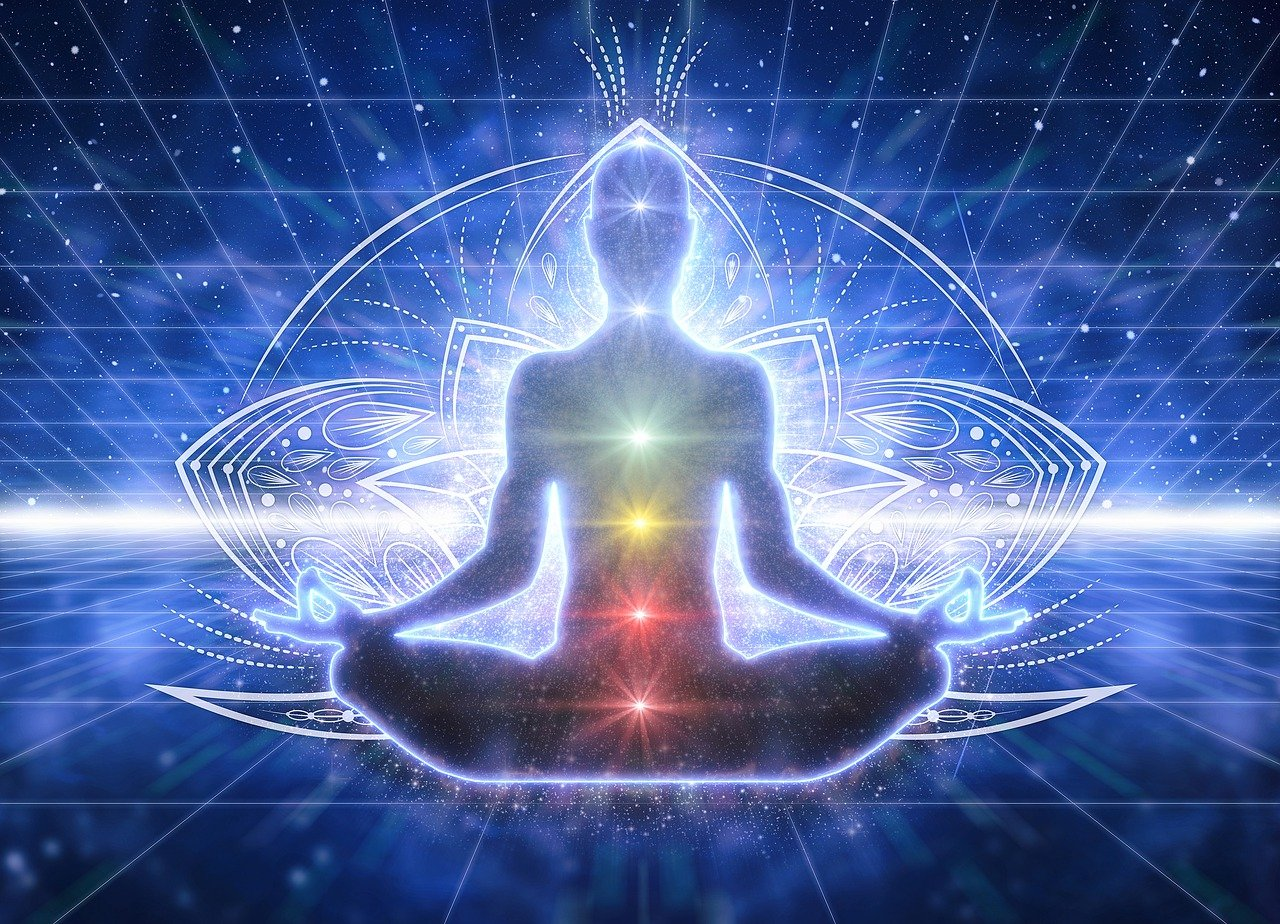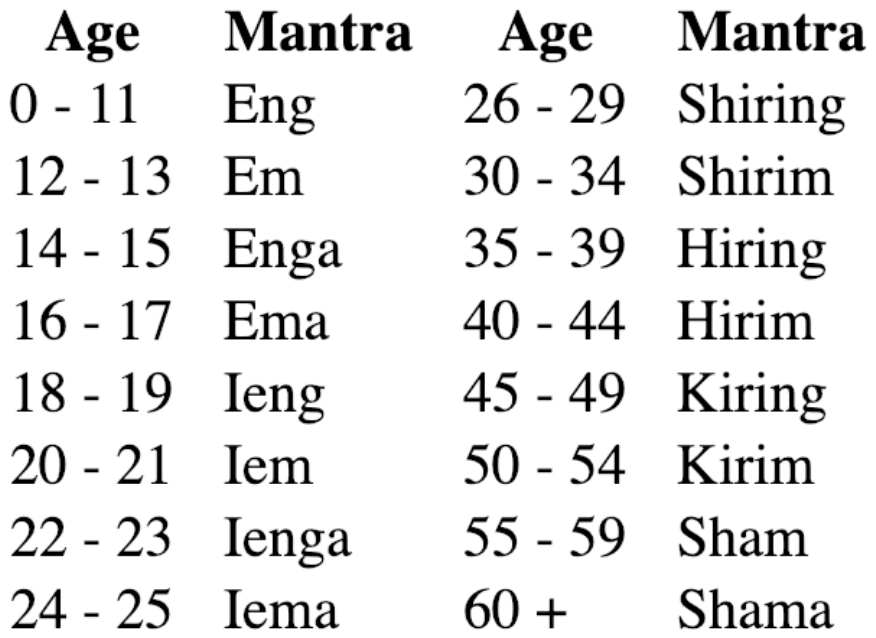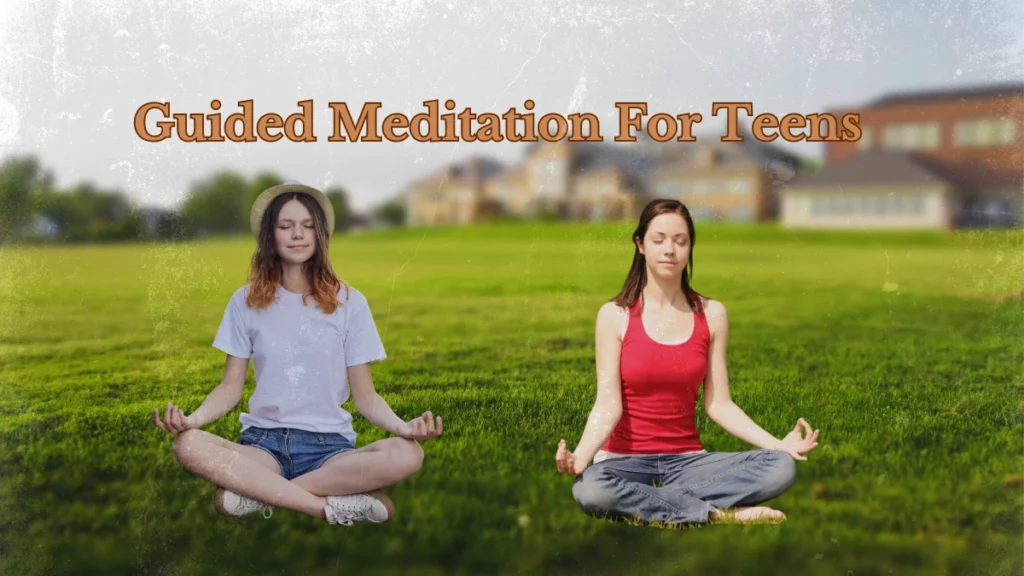|
Getting your Trinity Audio player ready…
|
Transcendental mantra meditation is a powerful practice that can help you achieve great states of consciousness and awareness. In this guide, we will discuss the basics of transcendent mantra meditation, and how you can use it to improve your life. We’ll also provide a list of transcendent mantras that you can use in your practice. So let’s get started!
- What is the transcendental meditation mantra and how does it work?
- What are the mantras for transcendental meditation?
- How to find your mantra for transcendental meditation?
- The benefits of transcendental meditation
- How are Transcendental Meditation (TM) mantras chosen ?
- How to get started with transcendental meditation mantras
- A step-by-step guide to practicing transcendental meditation
- A set of Meditation Mantras
- Transcendental meditation mantra chart
- Transcendental Meditation Mantras By Age
- Transcendental Meditation Mantras By Gender
- A few tips for deepening your practice
- How to use mantras in meditation to attain a state of transcendence
- How to use mantras to achieve your goals
- Conclusion
- FAQs on Transcendental Meditation Mantra
What is the transcendental meditation mantra and how does it work?
Mantra meditation is an ancient practice that has been used for centuries to help people achieve higher states of consciousness. The word “mantra” comes from the Sanskrit root man, which means “to think.” A mantra is a sacred word or phrase that is repeated during meditation. Mantras are believed to have special power and can be used to achieve specific goals.

Transcendental meditation is an art form of meditation that began in western society around the 1950s. This form of meditation came with its founder Maharishi Mahesh Yogi whose mission was to “spiritualize our world” and expand human consciousness. It has acquired a huge fanbase through its religion. It is often practiced using transcendental mantras and the term ‘TM mantras’ is widely used. During the meditation mantra, sounds are sacred vibrations and should be repeated at least once time during meditation.
There are many different transcendent mantras that you can use in your practice. Some of the most popular transcendental meditation mantras include “om,” “ah,” and “hu.” However, you can also use any word or phrase that has personal meaning to you. The important thing is to choose a mantra that you can repeat easily in your mind without getting distracted.
An uplifting mantra is a sound that does not have meaning. This is more important because mantras are meaningful to people. Transcendental Meditation involves taking a deep consciousness to the unconscious level in the unconscious mind and the TM mantra will allow us to settle into and transcend our thoughts and drop down to a deeply experienced level. If the mantra has meaning, it will stay in our minds.
When you repeat a mantra during meditation, it helps to still the mind and focus your attention on the present moment. The repetition of the mantra creates a vibration that can help to clear your mind and open your heart. Mantra transcendental meditation is a regular meditation practice that anyone can do, and it can be an incredibly powerful tool for self-transformation.
During this article, we are using a term called ‘TM’ to denote transcendental meditation. For example ‘TM technique’ means ‘transcendental meditation technique‘.
What are the mantras for transcendental meditation?
While there are many different mantras that can be used in TM, each individual is given a specific mantra to use based on age, gender, and level of development. The idea is that the use of a personal mantra will be more effective in promoting relaxation and achieving transcendence.
In addition to the use of a mantra, TM also involves sitting with the eyes closed and focusing on the breath. This combination of techniques is thought to help calm the mind and body, leading to a state of deep relaxation.
We will explain the Transcendental meditation mantra chart in the later of the article to help you to select your transcendental meditation mantra.
How to find your mantra for transcendental meditation?
The recommended way of finding a suitable TM Meditation mantra for you is a hiring certified TM teacher near you. The TM teacher recommends the mantra for you after having the initial session of the transcendental meditation.
We have a detailed post for the list of transcendental meditation mantras that includes the common mantras for TM and transcendental meditation mantras by age and gender.
The benefits of transcendental meditation
When it comes to a meditation session, there are many benefits that can be enjoyed. This type of transcendental meditation uses a specific word or phrase, which is repeated over and over again. The purpose of this is to help the meditator focus their attention and achieve a state of deeper relaxation.
Some of the transcendental meditation benefits that can be enjoyed from meditation include:
1. Improved mental clarity and focused attention
As the demands of work and family life become increasingly complex, it’s more important than ever to be able to maintain focus and stay on task. For many people, this can be a real challenge. Thankfully, there are a number of things you can do to improve your mental clarity and focus.
One of the most effective is to practice mindfulness meditation. This involves sitting quietly and focusing on your breath. As your mind starts to wander, simply bring your attention back to your breath. Over time, this practice will help you to develop greater focus and concentration. In addition, it can also help to reduce stress levels and promote feelings of calm and relaxation. If you’re looking for ways to boost your mental clarity and mental health, give mindfulness meditation a try.
2. Deeper levels of relaxation
When it comes to achieving a state of deep relaxation, many people turn to techniques like meditation or mindfulness. This meditation technique helps to quiet the mind and tune out outside distractions, allowing us to sink into a deep rest where tension and stress melt away. While this technique can be extremely effective when it comes to relaxation, they are not the only way to achieve deeper levels of peace and stillness.
In fact, there are many simple actions that anyone can do in their everyday life to help induce feelings of unbounded awareness and tranquility. For example, simply finding time each day for some light exercise can encourage your body and mind to slow down and unwind is an effortless technique.
Other activities like journalism or listening to soothing music can also promote relaxation from reduced stress and clear the mind of negative thoughts. While you are in a relaxed state it lowers your blood pressure and chronic pain if you are suffering. So if you’re looking for some simple ways to center yourself and escape from the stresses of everyday life and have better health, all you need is a little time and a few moments of a deep breath!
3. Greater self-awareness
The practice of meditation has been shown to lead to greater self-awareness and a greater sense. In a research study published in the journal Frontiers in Psychology, participants who meditated for eight weeks showed increased self-awareness on a number of measures.
The participants who meditated also showed increased mindfulness, which is the ability to be present in the moment and non-judgmental of one’s thoughts and feelings. The participants who did not meditate showed no changes in these measures. The findings suggest that meditation can lead to greater self-awareness, transcendental consciousness, and mindfulness, which can be beneficial for both mental and physical health.
4. Lower stress levels
In our fast-paced, constantly-connected world, it’s more important than ever to find ways to relax and de-stress. For many people, meditation is the perfect solution to trait anxiety. Studies have shown that meditation can help lower levels of stress and anxiety, improve sleep quality, avoid heart attacks and boost mood and overall well-being.
Additionally, meditation can be practiced anywhere, at any time. There is no need for special equipment or a quiet room; all you need is a few minutes and a willingness to relax while sitting comfortably. If you’re looking for a way to reduce stress and improve your overall health, give meditation a try.
5. Improved sleep quality

Sleep is essential for our physical and mental well-being. It allows our bodies to rejuvenate and repair, giving us the energy and generating the creative intelligence we need to tackle the challenges of each new day. However, many people struggle to get the amount of quality sleep that they need, leading to a host of negative side effects. One way to improve sleep quality is through meditation.
By learning how to calm your mind and control your breath, you can gain greater unbounded awareness of what is going on in your body and send yourself off to a peaceful slumber. Meditation also helps to reduce stress, which can contribute to better sleep quality by avoiding the body’s “fight or flight” response to negative emotions. With regular practice, meditation can help you achieve a deeper, more satisfying state of rest each night, leaving you energized and fully prepared for whatever tomorrow may bring.
If you’re looking to transcend the limitations of your mind and achieve higher states of transcendental consciousness, then transcendental meditation is an excellent tool. This type of meditation is often used by spiritual seekers and mystics who are looking to explore the deepest levels of their being.
If you’re interested in using transcendental meditation for personal development, then you can focus on specific goals or areas that you want to improve in your life. For example, if you want to increase your concentration and focus, you can use transcendental meditation to help you achieve this.
The key is to find the right mantra that resonates with you on a deep level. Once you’ve found your mantra, simply repeat it over and over again during your transcendental meditation.
If you’re looking to enjoy the health benefits of meditation such as lower blood pressure and staying away from cardiovascular disease, then transcendental meditation with a mantra could be the perfect option for you.
Read our full article for a detailed version of the benefits of transcendental meditation.
How are Transcendental Meditation (TM) mantras chosen ?
In Transcendental Meditation (TM), mantras are chosen by certified TM teachers, not by the practitioners themselves. These teachers assign a unique mantra to each student during an initiation ceremony.
The process is based on traditional knowledge passed down from the founder of TM, Maharishi Mahesh Yogi. The specific factors that guide the selection aren’t publicly disclosed, maintaining the personalized nature of the practice.
How to get started with transcendental meditation mantras
Now that you know what a mantra is and how it can help you transcend the chatter of your mind, you’re probably wondering how to get started with transcendental meditation. Let’s discuss how to do transcendental meditation.
The first step is finding a quiet place where you can sit or lie down comfortably without being disturbed. Once you’re settled, close your eyes and begin focusing on your breath to start the first session.
As you inhale and exhale, mentally repeat your chosen mantra while your eyes are closed. You can either say it out loud or silently to yourself. Continue repeating the mantra for as long as you like, letting go of all other thoughts that come into your mind.
When you’re finished, sit for a few moments with your eyes closed and simply observe the silence. Notice how your mind and body feel before slowly opening your eyes and getting up.
With correct practice, you’ll find that transcendental meditation can have a profound effect on your mental and physical well-being. Give it a try today and see for yourself!
Read our post for the ultimate step-by-step guide on how to do transcendental meditation with clear illustrations for more insights.
A step-by-step guide to practicing transcendental meditation
Now that you know what transcendental meditation is and how it can benefit you, it’s time to learn how to do it. Transcendental meditation is actually very simple and can be done by anyone.
Tradition says that Guru (TM teacher) for example the famous ‘Maharishi Mahesh Yogi’ passes the mantra to the students. You are also able to create a mantra that helps facilitate access to cosmic consciousness and practice it with personal instruction.
There are many different transcendental meditation mantras, but the most important thing is to choose one that feels comfortable for you. Once you’ve chosen your mantra, sit or recline in a comfortable position and close your eyes.
Begin to repeat your mantra silently to yourself. You can say it out loud if you prefer, but it’s not necessary. Continue repeating your mantra for 20 minutes, allowing yourself to sink deeper and deeper into a state of relaxation.
When you’re finished, sit for a few moments and allow yourself to slowly come back to the present. You may feel calmer and centered after transcendental meditation, and you can practice it as often as you like. Remember, there is no “right” or “wrong” way to meditate, so simply do what feels best for you.
If you’re looking for a more in-depth guide to transcendental meditation, check out the mantras list below. Happy meditating!
A set of Meditation Mantras

Om
Om is a sacred sound that has been revered in Indian spiritual traditions and religious practice for thousands of years. In the Hindu tradition, om represents the three faces of the Divine: creation, maintenance, and release or dissolution. Each part of the word corresponds to a different stage in the process of creation, and together they evoke a sense of oneness with the Divine.
In addition to its spiritual significance, om also carries creative energy that can be used to manifest our desires and intentions. Many yogis who are considered certified teachers believe that focusing on om before meditation helps to direct one’s intention and make our intentions more likely to come to fruition.
Whatever your beliefs about it may be, om is undeniably a powerful word with centuries of deep meaning behind it. So whether you use it for meditation or simply as a mantra for reflection and contemplation, take a moment to experience its beauty and power for yourself.
So Hum
So Hum is a powerful meditation technique that has been practiced for centuries in many cultures. Its basic premise is quite simple: the individual focuses on the process of their breath as it moves in and out of the body, silently repeating the words “so” and “hum” as they inhale and exhale.
At first glance, this meditation technique may seem to be little more than a tool for relaxation, but its benefits go much deeper than that. Through regular practice, So Hum has been proven to improve focus, calm the mind, and enhance self-awareness.
Additionally, scientific research has shown that it can help to reduce anxiety, and depression by raising levels of dopamine in the brain and high blood pressure. With all of these benefits, it’s no wonder that practitioners around the world have found such value in So Hum meditation. Whether you’re a seasoned meditator or just starting out, this powerful technique is sure to bring lasting peace and clarity into your life.
Hare Krishna
Hare Krishna is an ancient Vedic tradition that originated in India. The tradition is based on the teachings of the Bhagavad Gita, and it focuses on loving God and living a life of service.
There is a reason that the Bhagavad Gita is one of the most popular and widely read Hindu scriptures. It contains timeless wisdom that can help us live better lives, both on a personal level and in relation to others.
Adherents of Hare Krishna believe in the process of reincarnation and they strive to become free from the cycle of birth and death. They also believe in karma, and they strive to live a life of selfless service. The goal of Hare Krishna is to attain union with God.
The tradition has a strong emphasis on chanting, and members often chant the mantra below to make the sacred sound. You do not need to have teacher training to sound these wordings.
“Hare Krishna, Hare Krishna, Krishna Krishna, Hare Hare.”
The chanting is believed to help purify the soul and bring one closer to God. Hare Krishna is a devotional tradition that has many adherents throughout the world.
Sat Nam
Sat Nam is a Sikh mantra and salutation that translates to “true name.” It is often used as a form of greeting, and it can be used as a meditative practice.
The word “Sat” refers to truth, while “Nam” means name. Together, they represent the highest truth: the true name of God. In the Sikh tradition, there is only one God, and so the true name of God is also the true name of all things.
When we greet someone with “Sat Nam,” we are acknowledging the divine spark within them. We are reminding them of their true nature: infinite, perfect, and ever-present.
In addition to being a form of greeting, Sat Nam can also be used as a meditative practice. By repeating the mantra by producing scared sounds, we connect with our own inner truth. We quiet the mind and connect with our Divine nature. In this way, Sat Nam helps us to remember who we truly are and maintain a perfect stillness.
Aum Mani Padme Hum
Aum Mani Padme Hum is a Sanskrit mantra that is traditionally used as a prayer for compassion and wisdom. The mantra is thought to be associated with the bodhisattva Avalokiteshvara, who is known for his boundless compassion.
The six syllables of the mantra are often interpreted as symbolizing the six realms of samsara, or cyclic existence. By repeating the mantra, practitioners hope to purify their karma and escape the cycle of birth and death.
In addition, the mantra is said to bestow wisdom upon those who recite it, helping them to see the true nature of reality. For many Buddhists, Aum Mani Padme Hum is a powerful meditation technique for spiritual transformation.
Lakshmi Mantra
The ancient Hindu text known as the Lakshmi Mantra describes the power and beauty of the revered goddess Lakshmi. According to this sacred text, Lakshmi is the embodiment of wealth, abundance, and prosperity.
She fills our lives with riches of all kinds – material, spiritual, and emotional. Because she holds such a central place in the Hindu pantheon, countless people around the world have turned to the Lakshmi Mantra for guidance and insight into their own lives.
Whether you are seeking financial security or deep personal fulfillment, the rich and resonant words of this mantra will help you to connect with the powerful energy of Lakshmi and embrace all that she has to offer. With her grace and blessings, anything is possible.
So let go of your fears and doubts, raise your voice in praise of Lakshmi, and be open to all that she has in store for you. You can chant below to produce the sound of the Lakshmi mantra.
Om shreem hreem kleem glaum gam ganapataye vara varada sarvajanmein sadhike sthanu siddhim prakalpane namaha!
Praise Goddess Lakshmi now!
Gayatri Mantra
The Gayatri Mantra is one of the most well-known and beloved chants in Hinduism and yoga. Consisting of just three lines, the mantra has a simple yet powerful message that resonates with practitioners both young and old.
The chant calls upon the power of the sun to bring light into our lives, reminding us that we can tap into this great source of energy whenever we need it. With its uplifting message and soaring melodies, the Gayatri Mantra is a beautiful reminder of the peace and wisdom that can be found within ourselves.
So if you’re looking for an effective way to connect with your spiritual side, give this chant a try – you won’t be disappointed!
Om Namah Shivaya
Om Namah Shivaya is a sacred mantra that has been used by Hindus for centuries to invoke the blessings of Lord Shiva, one of the most revered deities in Hinduism. This powerful mantra is believed to have transformative powers, helping to cleanse and purify the body, mind, and soul.
By chanting ‘Om Namah Shivaya’ over and over again, we can make a sound to tune our minds to a state of stillness and gratitude, connecting ourselves with the divine energy that permeates all things. Whether you are a devout Hindu or simply seeking greater spiritual fulfillment, Om Namah Shivaya is an invaluable tool for achieving inner peace and awakening your true purpose in life.
So let us bow down before Lord Shiva and honor his sacred name with every breath we take. Om Namah Shivaya!
Maha Mrityunjaya Mantra
The Maha Mrityunjaya Mantra is one of the oldest and most sacred mantras in Hinduism. It is believed to have been written by Lord Shiva himself, as a way to offer protection and healing to those who chant it.
The mantra consists of three lines, each associated with a different aspect of healing and transformation. The first line calls upon Lord Shiva, symbolizing death and rebirth. The second line evokes Mother Divine, representing nourishment and fortitude. And the third line invokes director birds, emphasizing both freedom and comfort.
By chanting this powerful mantra, we can tap into its transformative energy, connecting us with the natural world and allowing us to transcend the trials of everyday life. So if you seek strength, wisdom, or healing, turn to the Maha Mrityunjaya Mantra – a timeless source of guidance and abundance.
Transcendental meditation mantra chart
There are many transcendental meditation mantras to choose from, and it can be tough to know which one is right for you. That’s why we’ve put together this transcendental meditation mantra chart.
This chart includes some of the most popular transcendental meditation mantras, as well as a guide to selecting transcendental meditation mantras by age.

Transcendental Meditation Mantras By Age
- Age 0 – 11 years old : Eng
- Age 12 – 13 years old : Em
- Age 14 – 15 years old : Enga
- Age 16 – 17 years old : Ema
- Age 18 – 19 years old : Ieng
- Age 20 – 21 years old : Iem
- Age 22 – 23 years old : Ienga
- Age 24 – 25 years old : Iema
- Age 26 – 29 years old : Shiring
- Age 30 – 34 years old : Shirim
- Age 35 – 39 years old : Hiring
- Age 40 – 44 years old : Hirim
- Age 45 – 49 years old : Kiring
- Age 50 – 54 years old : Kirim
- Age 55 – 59 years old : Shan
- Age 60 + years old : Shama
Transcendental Meditation Mantras By Gender
For Men
- Ram
- Ing
- Aing
- Shiring
- Shiam
For Women
- Shiram
- Im
- Aim
- Shirim
- Shiama
A few tips for deepening your practice
If you’re looking to deepen your transcendental meditation technique, there are a few things you can do.
First, make sure you’re using the right mantra for yourself.
Second, take a few deep breaths as your first TM movement.
third try to meditate for at least 20 minutes each day
fourth, be patient and consistent with your practice.
fifth, find a transcendental meditation teacher or group to help you deepen your practice.
sixth, try transcendental meditation techniques that go beyond the basic mantra.
By following these tips, you can deepen your transcendental meditation practice and experience all the benefits that come with it. If you could find a certified TM teacher it will be a blessing for you to do TM practice. namaste!
How to use mantras in meditation to attain a state of transcendence
Unlike the other forms of meditation that aim to control the mind, this meditation to attain a state of transcendence focuses on driving the reason inwards to the source of thought.
In order to use mantras effectively in meditation, it is important to understand what they are and how they work. A mantra is a sacred word or phrase that is repeated during meditation.
Mantras are words or phrases that are repeated during meditation. They can be in any language but are often in Sanskrit. This attracts and charms the mind, which itself is always searching for greater happiness, so the mind settles with the mantra of silence.
As the mind becomes more focused, the meditator may begin to experience a state of transcendence or a sense of oneness with the universe. When you transcend thinking, you enter a state of pure consciousness.
This is a state of being beyond thought, where you connect with your true self. In this state, you experience inner peace, happiness, and bliss. In order to maximize the effects of the mantra, it should be repeated with intention and mindfulness.
The meditator should focus on the meaning of the words and mentally visualize the desired outcome of the meditation. By doing so, it is possible to attain a state of deep peace, better mental health, and tranquility.
transcendental meditation mantras are the most effective for attaining transcendence. These mantras are specifically designed to take you into a deep state of meditation quickly and easily.
How to use mantras to achieve your goals
One powerful way to tap into the transcendental nature of reality is through the use of mantras. A mantra is a short, sacred phrase or syllable that is repeated during meditation. The repetition of mantras helps to still the mind and bring about a deep inner calm. There are good books on transcendental mediation that explain more depth knowledge and you can get more insight from these books.
There are many different mantras you can use for different purposes. If you want to achieve a specific goal, it can be helpful to choose a mantra that is related to that goal. For example, if you want to improve your health, you might use the mantra “Om Namah Shivaya,” which means “I honor the divine within.”
If you’re looking to add some transcendentalism into your life, look no further than mantras! Mantras are short, sacred phrases repeated during meditation that help to still the mind. If you want to achieve a specific goal, choose a mantra related to that goal.
The key is to choose a mantra that resonates with you on a deep level. Once you’ve found a mantra that feels right, repeat it in practice meditation. Over time, you’ll start to see the results you desire in your life.
Conclusion
A transcendental meditation program can help you achieve great states of transcendental consciousness and unbounded awareness. If you are looking to improve your life, we highly recommend giving a try to transcendent mantra-based meditation. The transcendent mantra meditation technique, we’ve outlined in this post is a surefire way to experience the many benefits of this type of meditation. The benefits of this type of meditation are vast and can include everything from improved mental clarity and mental health.
FAQs on Transcendental Meditation Mantra
What is a mantra?
A mantra is a short, sacred phrase or syllable that is repeated during meditation. The repetition of mantras helps to still the mind and bring about a deep inner calm.
How do I choose a mantra?
The key is to choose a mantra that resonates with you on a deep level. Once you’ve found a mantra that feels right, repeat it as often as you can during your meditation.
What are some examples of mantras?
If you want to achieve a specific goal, it can be helpful to choose a mantra that is related to that goal. For example, if you want to improve your health, you might use the mantra “Om Namah Shivaya,” which means “I honor the divine within.”
How long do I need to repeat a mantra?
There is no set amount of time that you need to repeat a mantra. The key is to focus on your breath and the feeling of the mantra, rather than on counting or keeping track of time.
Can I use more than one mantra?
Yes! You can use as many mantras as you like. Just be sure to focus on one mantra at a time during your meditation as a technique. It is a piece of common advice from many TM teachers.
Can I teach myself TM meditation?
While TM is typically taught by a certified instructor, it is possible to learn the basics of the practice on your own. There are a number of resources available that can help you get started, including books, websites, and apps. The key to success is to be patient and consistent with your practice.
What are the mantras for transcendental meditation?
– Om Namah Shivayae- Hare Krishna Hare Rama- Lakshmi Narayan Mantra- Gayatri Mantra
How do you do Transcendental Meditation?
The practice itself is very simple and can be done anywhere, at any time. First, the practitioner sits with their eyes closed and back straight. Next, they focus on their breath and allow their thoughts to come and go without judgment.Once they have settled into a comfortable rhythm, they begin to repeat a mantra, word, or phrase, either out loud or silently. The mantra is not intended to have any meaning; rather, it is meant to help the practitioner focus their attention.The goal of TM is not to empty the mind of all thought, but rather to let thoughts come and go without getting caught up in them. With regular practice, the practitioners report feeling more relaxed and less stressed. Transcendental Meditation can be learned from a certified teacher or through an online program.















